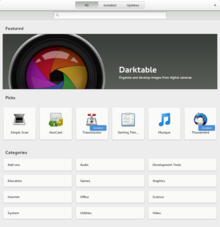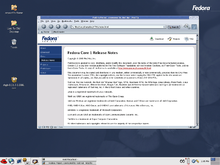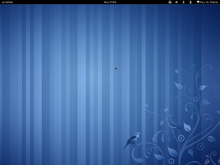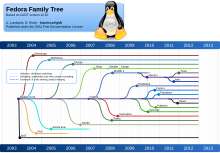Fedora Linux
 | |
 Fedora 20 (Heisenbug) with GNOME 3.10 | |
| Developer | Fedora Project (owned by Red Hat) |
|---|---|
| OS family | Unix-like |
| Working state | Current |
| Source model | Open source |
| Initial release | 6 November 2003[1] |
| Available in | Multilingual |
| Update method | Yum (PackageKit) |
| Package manager | RPM Package Manager |
| Platforms | IA-32, x86-64, ARM[2] |
| Kernel type | Linux |
| Userland | GNU |
| Default user interface | GNOME |
| License | Various free software licenses, plus proprietary firmware files.[3] |
| Official website | fedoraproject |
Fedora /f[invalid input: 'ɨ']ˈdɒr.ə/ (formerly Fedora Core) is an operating system based on the Linux kernel, developed by the community-supported Fedora Project and owned by Red Hat. Fedora contains software distributed under a free and open source license and aims to be on the leading edge of such technologies.[4][5]
Linus Torvalds, author of the Linux kernel, uses Fedora on all his computers.[6]
Features
Fedora has a reputation for focusing on innovation, integrating new technologies early on and working closely with upstream Linux communities. Making changes upstream instead of specifically in Fedora ensures that the changes are available to all Linux distributions.
Fedora has a relatively short life cycle: version X is supported only until 1 month after version X+2 and with approximately 6 months between versions, this means that a version of Fedora is supported for approximately 13 months.[7] This promotes leading-edge software because it frees developers from some backward compatibility restraints, but it also makes Fedora a poor choice for product development, which usually requires long-term vendor-support. Fedora users can upgrade from version to version using FedUp.[8]
The default desktop in Fedora is the GNOME desktop environment and the default interface is the GNOME Shell. Other desktop environments, including KDE, Xfce, LXDE, MATE and Cinnamon, are available and can be installed.[9][10]

Fedora uses the RPM package management system.
Security is also important in Fedora with one specific security feature being Security-Enhanced Linux, which implements a variety of security policies, including mandatory access controls, and which Fedora adopted early on.[11]
Software
Fedora comes installed with a wide range of software such as LibreOffice and Firefox. Additional software is available from the software repositories and can be installed using the yum or dnf package managers with graphical interfaces, such as GNOME Software, also being available.

Additionally, extra repositories can be added to the system, so that software not available in Fedora can be installed.[12]: Section 9.8.1. Third party repositories exist that distribute software not included in Fedora either because they don't meet Fedora's definition of free software or because their distribution may violate US law. One of the most popular third-party repositories is RPM Fusion. Fedora also provides users with an easy-to-use build system for creating their own repositories called Copr.[13]
Distribution
Fedora is distributed in several different ways:[12]: Section 2.1.3.
- Full Distribution on DVD – a DVD image with all major Fedora packages at the time of release;
- Live Image – a DVD image that can be used to create a Live DVD or Live USB drive and optionally install to a hard disk;
- Minimal Boot Media – used for installing directly over the network.
A Live USB drive can be created using Fedora Live USB creator or the dd command.[12]: Section 3.2.
Spins
Similar to Debian blends, the Fedora Project also distributes custom variations of Fedora called Fedora spins.[14] These are built with specific sets of software packages, offering alternative desktop environments or targeting specific interests such as gaming, security, design, scientific computing and robotics. Fedora spins are developed by several Fedora special interest groups.[14]
History
The Fedora Project was created in late 2003, when Red Hat Linux was discontinued.[15] Red Hat Enterprise Linux was to be Red Hat's only officially supported Linux distribution, while Fedora was to be a community distribution.[15] Red Hat Enterprise Linux branches its releases from versions of Fedora.[16]
The name of Fedora derives from Fedora Linux, a volunteer project that provided extra software for the Red Hat Linux distribution, and from the characteristic fedora hat used in Red Hat's "Shadowman" logo. Warren Togami began Fedora Linux in 2002 as an undergraduate project, intended to provide a single repository for well-tested third-party software packages so that non-Red Hat software would be easier to find, develop, and use. The key of Fedora Linux and Red Hat Linux was that Fedora's repository development would be collaborative with the global volunteer community.[17] Fedora Linux was eventually absorbed into the Fedora Project, carrying with it this collaborative approach.[18]
Before Fedora 7, Fedora was called Fedora Core after the name of one of the two main software repositories - Core and Extras. Fedora Core contained all the base packages that were required by the operating system, as well as other packages that were distributed along with the installation CD/DVDs, and was maintained only by Red Hat developers. Fedora Extras, the secondary repository that had been included since Fedora Core 3, was community-maintained and not distributed along with the installation CD/DVDs. Upon the release of Fedora 7, the distinction between Fedora Core and Fedora Extras was eliminated.[19]
Fedora is a trademark of Red Hat, Inc. Red Hat's application for trademark status for the name "Fedora" was disputed by Cornell University and the University of Virginia Library, creators of the unrelated Fedora Commons digital repository management software.[20] The issue was resolved and the parties settled on a co-existence agreement that stated that the Cornell-UVA project could use the name when clearly associated with open source software for digital object repository systems and that Red Hat could use the name when it was clearly associated with open source computer operating systems.[21]
Releases
The current release is Fedora 20, codenamed "Heisenbug", which was released on 17 December 2013.


| Version[22] | Release[22] | End-of-life[23] | Kernel[24][a] | GNOME[24] |
|---|---|---|---|---|
| 1 (Yarrow) | 2003-11-06 | 2004-09-20 | 2.4.22 | 2.4 |
| 2 (Tettnang) | 2004-05-18 | 2005-04-11 | 2.6.5 | 2.6 |
| 3 (Heidelberg) | 2004-11-08 | 2006-01-16 | 2.6.9 | 2.8 |
| 4 (Stentz) | 2005-06-13 | 2006-08-07 | 2.6.11 | 2.10 |
| 5 (Bordeaux) | 2006-03-20 | 2007-07-02 | 2.6.15 | 2.14 |
| 6 (Zod) | 2006-10-24 | 2007-12-07 | 2.6.18 | 2.16 |
| 7 (Moonshine) | 2007-05-31 | 2008-06-13 | 2.6.21 | 2.18 |
| 8 (Werewolf) | 2007-11-08 | 2009-01-07 | 2.6.23 | 2.20 |
| 9 (Sulphur) | 2008-05-24 | 2009-07-10 | 2.6.25 | 2.22 |
| 10 (Cambridge) | 2008-11-25 | 2009-12-18 | 2.6.27 | 2.24 |
| 11 (Leonidas) | 2009-06-09 | 2010-06-25 | 2.6.29 | 2.26 |
| 12 (Constantine) | 2009-11-17 | 2010-12-02 | 2.6.31 | 2.28 |
| 13 (Goddard) | 2010-05-25 | 2011-06-24 | 2.6.33 | 2.30 |
| 14 (Laughlin) | 2010-10-29 | 2011-12-08 | 2.6.35 | 2.32 |
| 15 (Lovelock) | 2011-05-24 | 2012-06-26 | 2.6.38 | 3.0 |
| 16 (Verne) | 2011-11-08 | 2013-02-12 | 3.1 | 3.2 |
| 17 (Beefy Miracle) | 2012-05-29 | 2013-07-30 | 3.3 | 3.4 |
| 18 (Spherical Cow) | 2013-01-15 | 2014-01-14 | 3.6 | 3.6 |
| 19 (Schrödinger's Cat) | 2013-07-02 | 2015-01-06 | 3.9 | 3.8 |
| 20 (Heisenbug) | 2013-12-17 | 2015-06-23 | 3.11 | 3.10 |
| 21[26] | 2014-12-09 | 2015-12-01 | 3.17 | 3.14 |
| 22 | 2015-05-26 | 2016-07-19 | 4.0 | 3.16 |
| 23 | 2015-11-03 | 2016-12-20 | 4.2 | 3.18 |
| 24 | 2016-06-21 | 2017-08-08 | 4.5 | 3.20 |
| 25 | 2016-11-22 | 2017-12-12 | 4.8 | 3.22 |
| 26 | 2017-07-11 | 2018-05-29 | 4.11 | 3.24 |
| 27 | 2017-11-14 | 2018-11-30 | 4.13 | 3.26 |
| 28 | 2018-05-01 | 2019-05-28 | 4.16 | 3.28 |
| 29 | 2018-10-30 | 2019-11-26 | 4.18 | 3.30 |
| 30 | 2019-05-07 | 2020-05-26 | 5.0 | 3.32 |
| 31 | 2019-10-29 | 2020-11-24 | 5.3 | 3.34 |
| 32 | 2020-04-28 | 2021-05-25 | 5.6 | 3.36 |
| 33 | 2020-10-27 | 2021-11-30 | 5.8 | 3.38 |
| 34 | 2021-04-27 | 2022-06-07 | 5.11 | 40 |
| 35 | 2021-11-02 | 2022-12-13 | 5.14 | 41 |
| 36 | 2022-05-10 | 2023-05-16 | 5.17 | 42 |
| 37 | 2022-11-15[27] | 2023-12-05[28] | 6.0 | 43 |
| 38 | 2023-04-18[29] | 2024-05-21[29] | 6.2 | 44 |
| 39 | 2023-11-07[28] | 2024-11-12[28] | 6.5 | 45 |
| 40 | 2024-04-23[30] | 2025-05-13[30] | 6.8 | 46 |
| 41 | 2024-10-15[31] | [to be determined] | [to be determined] | 47 |
Legend: Old version Older version, still maintained Latest version Latest preview version Future release | ||||

Derivatives

Some notable Fedora derivative Linux distributions are:[32]
- Korora – a complete and easy to use system for general computing that “just works” out of the box.
- OLPC OS – for the One Laptop per Child laptops.
- Red Hat Enterprise Linux – enterprise Linux offering from Red Hat, which branches from the current Fedora baseline.
See also
References
- ^ Nottingham, Bill (6 November 2003). "Announcing Fedora Core 1". Fedora Project announce (Mailing list). Retrieved 18 May 2014.
{{cite mailing list}}: Unknown parameter|mailinglist=ignored (|mailing-list=suggested) (help) - ^ "Architectures". Fedora Project. Retrieved 25 April 2014.
- ^ "Frequently Asked Questions about Fedora Licensing". Fedora Project. Retrieved 27 March 2014.
- ^ Spevack, Max (18 August 2006). "Fedora Project Leader Max Spevack Responds". Slashdot. Retrieved 17 December 2006.
- ^ "Objectives". Fedora Project. Retrieved 12 February 2007.
- ^ "Interview with Linus Torvalds from Linux Format 163". TuxRadar. Linux Format. 29 November 2012. Retrieved 3 February 2014.
- ^ "Fedora Release Life Cycle". Fedora Project. Retrieved 25 March 2014.
- ^ "FedUp". Fedora Project. Retrieved 25 March 2014.
- ^ Linder, Brad (29 May 2012). "Fedora 17 now available for download". Liliputing. Retrieved 30 May 2012.
- ^ Brodkin, Jon (15 January 2013). "How to install the MATE and Cinnamon desktops on Fedora 18". Ars Technica. Retrieved 15 January 2013.
- ^ Spenneberg, Ralf (August 2006). "Security Hardened - Mandatory Access Control with SELinux" (PDF). Linux Magazine, Issue 69. Linux New Media USA. Retrieved 7 October 2007.
- ^ a b c "Fedora 20 Installation Guide". Fedora Project. Retrieved 19 May 2014.
- ^ "Fedora Copr". Fedora Project. Retrieved 27 March 2014.
- ^ a b "Fedora Spins". Fedora Project. Retrieved 3 February 2014.
- ^ a b Johnson, Michael K. (22 September 2003). "Fedora Project: Announcing New Direction". Fedora development (Mailing list). Retrieved 18 October 2007.
{{cite mailing list}}: Unknown parameter|mailinglist=ignored (|mailing-list=suggested) (help) - ^ Burke, Tim (August 2006). "The Fedora Project and Red Hat Enterprise Linux, part 4". Red Hat Magazine, Issue #22. Red Hat. Retrieved 18 October 2007.
- ^ Barr, Joe (1 October 2003). "Warren Togami on the new Fedora Project". Linux.com. Retrieved 9 February 2010.
- ^ Togami, Warren (February 2006). "Why Fedora?" (ODP). Retrieved 30 April 2011.
- ^ "Releases/7". Fedora Project. Retrieved 27 February 2014.
- ^ Becker, David (21 November 2003). "Red Hat, researchers in name tiff". CNET News. CBS Interactive Inc. Retrieved 3 February 2014.
- ^ "Fedora Repository Project History". Retrieved 3 February 2014.
- ^ a b "Releases/HistoricalSchedules". Fedora Project. Retrieved 11 August 2015.
- ^ "End of life". Fedora Project. Retrieved 11 May 2014.
- ^ a b "Fedora Linux". DistroWatch. Retrieved 15 May 2014.
- ^ "KernelRebases". Fedora Project. Retrieved 18 May 2014.
- ^ Boyer, Josh (2 October 2013). "Release Name process ended". Fedora community advisory board mailing list. Retrieved 11 May 2014.
- ^ "Fedora Linux 37 Schedule". Fedora Project.
- ^ a b c "Fedora Linux 39 Schedule". Fedora Project.
- ^ a b "Fedora Linux 38 Schedule". Fedora Project.
- ^ a b "Fedora Linux 40 Schedule". Fedora Project.
- ^ "Fedora Linux 41 Schedule". Fedora Project.
- ^ "List of Fedora derived Linux distributions". DistroWatch. Retrieved 11 May 2014.
External links
Template:MATE Template:Xfce Template:LXDE
